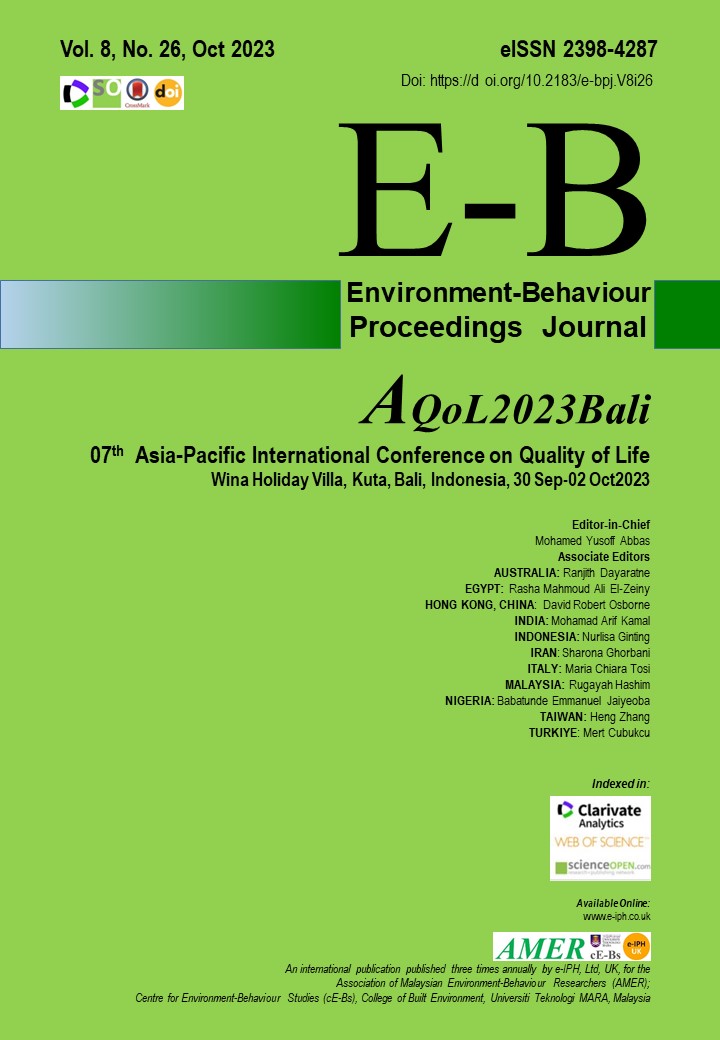A Scientometric Analysis and Critical Review of Research on English for Specific Purposes Using Citespace
DOI:
https://doi.org/10.21834/e-bpj.v8i26.5121Keywords:
English for Specific Purposes, Scientometric Analysis, Trends, CitationAbstract
A few researchers conducted systematic reviews of literature on this field to understand the historical development of English for Specific Purposes. However, a holistic review combining scientometric analysis and critical review in the last ten years is still lacking. Based on 1528 bibliometric records from 2011 to 2022 retrieved from the Web of Science core collection, the study aims to provide a systematic and objective overview of ESP research via Citespace. The results provide references for understanding this field's research status quo, themes, and current trends.
References
Bahrami, V., Hosseini, M., & Atai, M. R. (2019). Exploring research-informed practice in English for academic purposes: A narrative study. English for Specific Purposes, 54, 152-165. https://doi.org/10.1016/j.esp.2019.02.003 DOI: https://doi.org/10.1016/j.esp.2019.02.003
Basturkmen, H. (2021). ESP Research Directions: Enduring and Emerging Lines of Inquiry. Language Teaching Research Quarterly, 23, 5-11. https://doi.org/10.32038/ltrq.2021.23.02 DOI: https://doi.org/10.32038/ltrq.2021.23.02
Chen, C. (2017). Science mapping: a systematic review of the literature. Journal of data and information science, 2(2), 1-40. https://doi.org/10.1002/asi.20317 DOI: https://doi.org/10.1515/jdis-2017-0006
Diao, B. C., Adnan, N., Harji, M. B., & Ravindran, L. (2022). Evolution and hotspots of peer instruction: a visualized analysis using CiteSpace. Education and Information Technologies, 1-18. https://doi.org/10.1007/s10639-022-11218-x DOI: https://doi.org/10.1007/s10639-022-11218-x
Dovhanets, V. I. (2020). Students’ Cognitive autonomy in the process of English for Specific Purposes learning: a model of IT implementation into traditional teaching. Information Technologies and Learning Tools, 78(4), 105-115. http://doi.org/10.33407/itlt.v78i4.2833 DOI: https://doi.org/10.33407/itlt.v78i4.2833
Du, J., Li, W., & Li, Q. (2022). Who Are We, What Can We Do, and What Do We Think? Review on EAP Teacher Development. Chinese Journal of Applied Linguistics, 45(4), 532-550. http://doi.org/10.1515/CJAL-2022-0403 DOI: https://doi.org/10.1515/CJAL-2022-0403
Dudley-Evans, T. & St John, M. J. (1998). Developments in English for Specific Purposes: A Multi - Disciplinary Approach. Cambridge University Press.
Durovic, Z. (2021). Corpus Linguistics Methods for Building ESP Word Lists, Glossaries and Dictionaries on the Example of a Marine Engineering Word List. Lexikos, 31, 259-282. http://doi.org/10.5788/31-1-1647 DOI: https://doi.org/10.5788/31-1-1647
Green, C., & Lambert, J. (2018). Advancing disciplinary literacy through English for academic purposes: Discipline-specific wordlists, collocations and word families for eight secondary subjects. Journal of English for Academic Purposes, 35, 105-115. https://doi.org/10.1016/j.jeap.2018.07.004 DOI: https://doi.org/10.1016/j.jeap.2018.07.004
Guo, G., & He, B. (2020). Evaluation of Business English Writing Course-book Based on the Needs Analysis Model. International Linguistics Research, 3(3), 11-21. https://doi.org/10.30560/ilr.v3n3p11 DOI: https://doi.org/10.30560/ilr.v3n3p11
Horváthová, B., & Naďová, L. (2021). Developing critical thinking in reading comprehension of texts for specific purposes at all levels of Bloom’s taxonomy. Journal of Teaching English for Specific and Academic Purposes, 1-16. http://dx.doi.org/10.22190/JTESAP2101001H DOI: https://doi.org/10.22190/JTESAP2101001H
Jia, S. J., & Harji, M. B. (2023). Themes, knowledge evolution, and emerging trends in task-based teaching and learning: A scientometric analysis in CiteSpace. Education and Information Technologies, 1-20. http://doi.org/10.1007/s10639-023-11586-y DOI: https://doi.org/10.1007/s10639-023-11586-y
Jiang, A. L., Zhang, L. J., May, S., & Qin, L. T. (2020). Understanding novice teachers’ perceived challenges and needs as a prerequisite for English curriculum innovation. Language, Culture and Curriculum, 33(1), 15-31. http://doi.org/10.1080/07908318.2018.1518452 DOI: https://doi.org/10.1080/07908318.2018.1518452
Johns, A. M. (2012). The history of English for specific purposes research. The handbook of English for specific purposes, 5-30. https://doi.org/10.1002/9781118339855.ch1 DOI: https://doi.org/10.1002/9781118339855.ch1
Kaivanpanah, S., Alavi, S. M., Bruce, I., & Hejazi, S. Y. (2021). EAP in the expanding circle: Exploring the knowledge base, practices, and challenges of Iranian EAP practitioners. Journal of English for Academic Purposes, 50, 100971. http://doi.org/10.1016/j.jeap.2021.100971 DOI: https://doi.org/10.1016/j.jeap.2021.100971
Lim, J. M. H. (2017). Writing descriptions of experimental procedures in language education: Implications for the teaching of English for academic purposes. English for Specific Purposes, 47, 61-80. https://doi.org/10.1016/j.esp.2017.05.001 DOI: https://doi.org/10.1016/j.esp.2017.05.001
Liu, Y., & Hu, G. (2021). Mapping the field of English for specific purposes (1980–2018): A co-citation analysis. English for Specific Purposes, 61, 97-116. https://doi.org/10.1016/j.esp.2020.10.003 DOI: https://doi.org/10.1016/j.esp.2020.10.003
Otto, P. (2021). Choosing specialized vocabulary to teach with data-driven learning: An example from civil engineering. English for Specific Purposes, 61, 32-46. https://doi.org/10.1016/j.esp.2020.08.003 DOI: https://doi.org/10.1016/j.esp.2020.08.003
Payant, C., McDonough, K., Uludag, P., & Lindberg, R. (2019). Predicting integrated writing task performance: Source comprehension, prewriting planning, and individual differences. Journal of English for Academic Purposes, 40, 87-97. http://doi.org/10.1016/j.jeap.2019.06.001 DOI: https://doi.org/10.1016/j.jeap.2019.06.001
Rose, H., Curle, S., Aizawa, I., & Thompson, G. (2020). What drives success in English medium taught courses? The interplay between language proficiency, academic skills, and motivation. Studies in Higher Education, 45(11), 2149-2161. https://doi.org/10.1080/03075079.2019.1590690 DOI: https://doi.org/10.1080/03075079.2019.1590690
Selvaraj, M., & Aziz, A. A. (2019). Systematic review: Approaches in teaching writing skill in ESL classrooms. International Journal of Academic Research in Progressive Education and Development, 8(4), 450-473. http://doi.org/10.6007/IJARPED/v8-i4/6564 DOI: https://doi.org/10.6007/IJARPED/v8-i4/6564
Sönmez, H. (2019). An examination of needs analysis research in the language education process. International Journal of Education and Literacy Studies, 7(1), 8-17. https://doi.org/10.7575/aiac.ijels.v.7n.1p.8 DOI: https://doi.org/10.7575/aiac.ijels.v.7n.1p.8
Xu, J. J., Cheng, L., & Dong, Y. F. (2022). International Academic English Research Hotspots and frontiers (1085-2021), a Citespace-based visual analysis. Journal of Harbin University, 43(09).123-126. http://doi.org/10.3969/j.issn.1004-5856.2002.09.029
Downloads
Published
How to Cite
Issue
Section
License
Copyright (c) 2023 Si Ning Tan, Madhubala Bava Harji, Xiao Gang Hu

This work is licensed under a Creative Commons Attribution-NonCommercial-NoDerivatives 4.0 International License.





